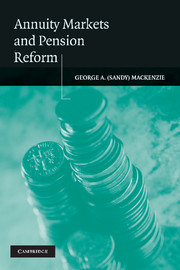Appendix 2 - Aging and Its Impact on Pension Systems
Published online by Cambridge University Press: 13 November 2009
Summary
A PARABLE
The nineteenth century economists were accustomed to illustrating their arguments with stories about a “Robinson Crusoe” economy – a barter economy with only one inhabitant. The basics of the economics of aging can be illustrated in a similar way, although the economy's population must be greater than one since it must span at least three generations. Imagine a small island economy, Arcadia, organized like a collective. Arcadia has for some time had a static population with a stable demographic pyramid – the two dependency ratios have each been constant for some time. In addition, there is positive gross but zero net investment, so the stock of capital (fishing boats, nets, tools, and the like), like the supply of labor has also been constant for some time.
One day, two momentous trends emerge: Arcadia's birth rate drops, and the life expectancy of its elders (i.e. their life expectancy at the time they stop working) increases. If the Arcadians are prescient, they will realize that in about 15 years the labor supply will begin to fall, assuming that retirement continues to begin at the accustomed age, because the number of new entrants to the Arcadian labor force does not match the number of retirees leaving it. They should also notice, perhaps more quickly, that the total amount of time their society needs to devote to the care and upbringing of children (to provide the traditional standard of care and upbringing per child) will decline.
- Type
- Chapter
- Information
- Annuity Markets and Pension Reform , pp. 225 - 230Publisher: Cambridge University PressPrint publication year: 2006



